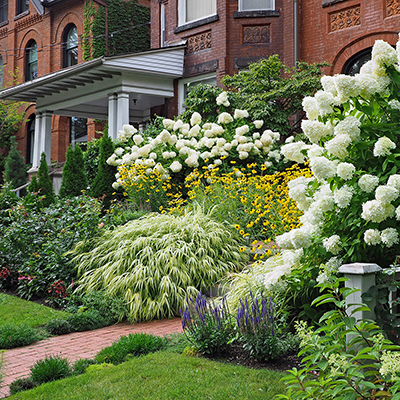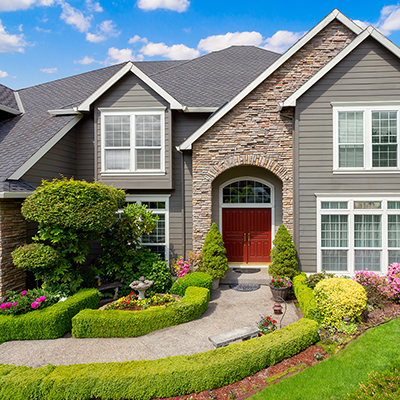How to Grow and Care for Boxwoods

Last updated July 11, 2024
Boxwood shrubs are one of the most popular evergreen shrubs for landscapes. There are few evergreen shrubs more stately than a trimmed boxwood hedge or topiary.
In addition to classic and consistent good looks, boxwood shrubs are evergreen in winter throughout most of the country, as well as deer-resistant and low-maintenance.
Read on to discover more about how to grow and care for boxwood shrubs in your landscape.
Table of Contents
How to Choose a Boxwood Shrub
Where and How to Plant a Boxwood Shrub
How to Care for Boxwoods
Boxwood Blight and Boxwood Alternatives
How to Choose a Boxwood Shrub

Know your site and light when selecting the right boxwood for your project. Boxwoods like full sun, but not extreme heat. Read plant tags and research online to find the cultivars that can handle heat.
Boxwoods thrive in the South and Midwest. North of zone 5, boxwoods may be damaged in winter weather. Northern gardeners may have good results planting boxwoods in containers and protecting them in temperatures below -20 degrees Fahrenheit.
With hundreds of cultivars, boxwood comes in all shapes, shades and sizes. English boxwood doesn’t handle heat as well as its Asian counterparts, so plant those varieties in partial shade or in morning sun.
Korean boxwood is very hardy and grows well in full sun. There are also boxwood hybrids like Green Gem and Green Velvet. Look for patio-sized varieties that will thrive in planters.
Where and How to Plant a Boxwood Shrub

Boxwoods can handle full sun to part shade. If you live in an area with extreme heat, plant boxwoods so they're shaded from hot afternoon sun. Boxwoods need easy draining soil with a slightly alkaline pH.
You can plant boxwood any time of year that the soil is easy to work in. The best times of year to plant shrubs are in early spring and in fall because the combination of warm days, cool nights and wetter weather allows plants to establish root systems without heat stress. If you plant shrubs in hot weather, remember to water often and monitor the plants for heat stress.
How to plant boxwood shrubs:
- Select a spot with evenly moist soil that drains well.
- Perform a soil test. Amend soil to keep pH between 6.8 and 7.5.
- Dig a hole no greater than the depth of the root ball and two to three times as wide.
- Loosen roots before planting. Plant the crown of the boxwood shrub slightly above the surface.
- Backfill hole with native soil, compressing lightly to remove any air pockets.
- Water thoroughly and then layer a couple inches of mulch. Keep mulch away from the trunk. Do not mound mulch around the stem like a volcano.
Tip: If the pH is on target, it’s not always necessary to amend the planting hole with compost or organic matter. In the case of amending clay soil, although it’s hard for gardeners to dig in, sometimes it's well-draining enough for shrubs to send out their roots.
How to Care for Boxwoods

You can give your garden shears a break when you plant the newer, more compact boxwood varieties. Pick up your pruners instead and thin out unruly and damaged branches as needed.
Newly planted boxwoods will need plenty of water to get established. In dry weather, place a soaker hose around the shrubs and cover with mulch. Set an irrigation timer to regulate the water flow.
Once established, most boxwood shrubs can handle dry spells. Still, water shrubs during droughty conditions.
Applying fertilizer will help boxwoods keep their vibrant green color. Look for a slow-release nitrogen fertilizer and apply annually in spring.
Boxwood Blight and Boxwood Alternatives

Boxwood blight is a devastating disease that infects and destroys boxwoods. Blight begins with brown spots on the leaves and eventually kills the entire plant. Boxwoods grown in hedges are particularly vulnerable to blight.
Once the disease is introduced in your garden, it can be a problem throughout the entire landscape. That's why it's important to identify blight early and take steps to eradicate it from your garden.
The good news is that blight-resistant cultivars are available. If you're planting new shrubs, look for these varieties online and in the Garden Center.
At the first sign of problems with boxwood blight, remove and destroy the infected plant. Place in a plastic garbage bag and throw in a trash can. It’s a good gardener’s practice to disinfect your pruners routinely to prevent the spread of blight (and other fungal diseases).
You may want to plant shrubs that have the merits of boxwoods without the problem of blight. Popular alternatives to boxwood include:
- Dystilium
- Dwarf arborvitae
- Dwarf yaupon holly
- Japanese holly like “Sky Pencil”
- Spreading yew
Flowering shrub alternatives to boxwood:
- Abelia
- Azalea
- Camellia
- Winter daphne
Healthy green boxwood shrubs ground your garden and landscape. When you're ready to plant boxwoods and you're looking for the right tools, shrubs or garden soil, The Home Depot delivers online orders when and where you need them.
































